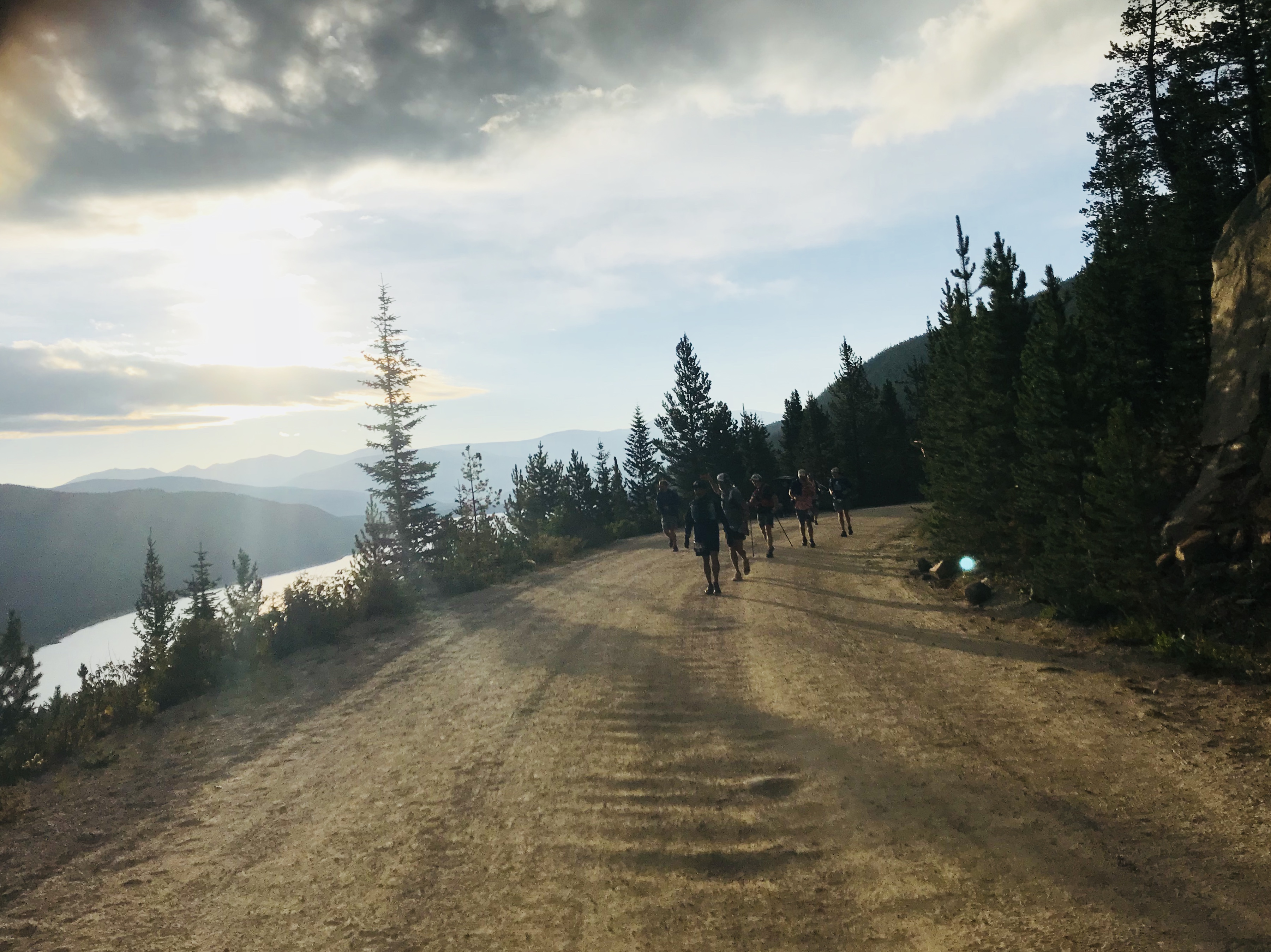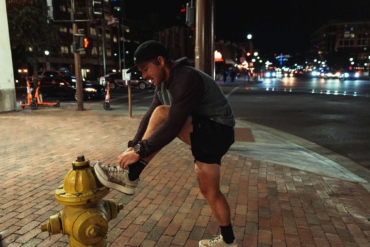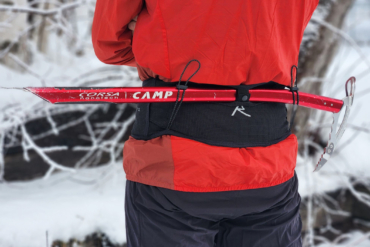The iconic ‘race across the sky’ was one tough run, but I finished in 2018. In doing so, I came away with a few thoughts that may help out other Leadville 100 runners toeing the line for the first time.
A man shivers uncontrollably to my left. His friends and what I assume are paramedics work quickly to wrap him in heavy coats and blankets and blast him with a propane heater. His face contorts, eyes closed, as he lets out a soft moan.
To my right, my wife tries to distract me from the horror show the next stool over at the aid station. Focus on the task at hand: Eat a small cup of salty broth laced with mushy noodles. It’s 2 o’clock in the morning, and I’ve been running for 21 hours through the Rocky Mountains. A cold, wind-driven rain has been pounding from the sky for two hours.
Welcome to Leadville.
Leadville 100: Buckle Down
Having already completed a couple of 100-kilometer races, plus the Grand Canyon 100-miler and multiple TransRockies Runs, I knew a little of what to expect before I accepted an invitation to run the Leadville 100.
But the monster officially dubbed the CenturyLink Leadville Trail 100 Run is a different beast altogether. It’s been a month since I crossed the finish line in 28 hours, 36 minutes, 51 seconds. While I’ve wanted to share the experience, it’s been really hard to process mentally. So I’ve procrastinated, pondered, and watched toenails fall off (only two so far) while ruminating on it.
For those considering the burly Colorado run, here are a few things I learned that might help you along the way.
Leadville 100 Gear That Worked
I honed my kit to fit my style of running. That means gear that can keep a modest finisher moving hour after hour.
I finished the Leadville 100 with very few problems other than serious exhaustion and some sore joints. I had no chafing! No stomach problems (well, I puked twice, but to me, that’s a win)! And I lost only two toenails (way better than average)!
Below is all the gear I used.
Salomon vest: The Skin Pro 10 vest carried all my gear (jacket, food, phone, etc). It was comfortable with minimal bouncing. It also carried a hydration bladder, which I prefer over water bottles. I used a pre-release version of one coming to market in 2019 and loved it. Look for a full review soon.
HOKA ONE ONE Torrent and EVO Mafate shoes: I used shoes from several brands during training, but when it came to race day, I settled into HOKAs. I used the Torrent over the more technical Hope Pass section of the race and relied on the EVO Mafate for big miles. They were great.
Older Salomon shorts: I don’t think Salomon makes the shorts I wore anymore, but they have a snug liner inside a looser-fitting exterior. No underwear. No chafing. I didn’t change them throughout the race but did switch to underwear and tights late at night when it got cold.
Altra Performance 2.0 T-Shirt: This shirt is light. It has perforations that allow it to breathe really well. I wore it for 100 miles and had zero chafing. It’s my favorite running shirt yet!
Revant S1L sunglasses: Comfortable and light, the S1L shades kept my eyes happy during sunny portions of the day. A very cool note on these glasses is they can be repaired and are meant to be worn for a lifetime. They’re 100 miles in and still rolling.
Fjällräven Abisko Eco-Shell Jacket: This jacket saved my ass, but it’s not a running jacket. Instead, this is a full-on waterproof-breathable shell. I wore it during a gnarly rainstorm at night. Without it, I would have frozen. It kept me warm enough to keep running when things got very cold.
Headlamp: I had a bunch of headlamps in a bag and grabbed one. And honestly, I’m not sure which I used. I’m pretty sure the Petzl Tikka made most of the trip with me, although I may have switched to a Princeton Tec Sync at some point. The late-night slog is a hazy memory.
Merino socks: I wore about four pairs of various merino wool socks through the run. That’s what I recommend. I used pairs by Smartwool and Darned Tough. I like higher socks because I tend to kick my calves from time to time and it protects them from the sharp corners of running shoes. To me, a good light merino sock is critical. Find some for hiking or every day, and they’ll translate great into running.
Black Diamond Distance Carbon Z poles: This was a tough choice, as I also had a new model from Ultimate Direction that’s really nice. But I ultimately decided to use the Distance Carbon Z poles because they fold down small. I didn’t start using poles until Hope Pass and wasn’t sure I’d want them on the descent. But I ended up using them for the entire last 60 miles of the race.
Bodyglide: This stuff is clutch. At one point, I noticed the very early sensation of chafing in my groin and hit it immediately with Bodyglide. It never got worse. I used this stuff about 10 times through the run, and it kept chafing to a minimum.
SaltStick: I can’t over-recommend this one. But of course, you need to know your own body. I took probably 20 or so SaltStick tabs over the race. They replenish electrolytes lost through sweat. Given that I drank gallons upon gallons of water during the run, SaltStick was absolutely key to avoiding some really nasty health problems. Use them.
Bumkins Reusable Snack Bags: Ok, ok, I know this is goofy. But I freaking love these things. I used the Bumkins Reusable Snack Bag to store my SaltStick along with a few Gin Gins and Tylenol tabs. I also use them to carry sandwiches to work, but that’s a whole other story.
Start Slow (No, Really, Start Slow!)
The Leadville 100 is a lot bigger than most ultramarathons. With about 750 people toeing the starting line, it’s a real pack at the beginning. I rarely found myself alone on the trail.
And while it was fun and surreal, that pack really sucks you along. I’d spoken with a few finishers who all cautioned over and again to start really slow. The beginning also happens to be mostly downhill, so it would be easy to look down and see yourself ticking off eight-minute miles.
I resisted the urge reasonably well and rolled into the first aid station averaging 11:12 per mile. Slower would probably have been better, but with fresh legs, there’s only so much I could do to push back my pace.
Run Fast Downhill (When You Can)
I guess this one could be controversial, but it worked for me. I ran the downhills fast, especially early in the race.
For example, the extremely steep descent known as Powerline is a real leg burner whether you go fast or not. Take a look at this video shot by a participant in 2017 and you’ll get an idea of the energy runners use to slow down.
So as I rolled down the first section, I decided to let my legs roll a little and wound up flying down it, averaging (I’m guessing) seven-minute miles. It burned a little, but probably not much more than going slow, and it got me out of the steep descent faster. It also pushed me past dozens of other runners.
I used fast descents as much as I could through the race, although it got harder and harder in later miles to push much pace.
Respect the Weather (And Carry a Rain Jacket)
Leadville is high in the Rocky Mountains, and the weather is fickle. During the 2018 race, weather ranged from sunny skies and cool mountain air to lashing rain and wind in the near-freezing dark.
Maybe I was naive going in. Maybe summer lulled me into a false sense of security. Whatever the reason, I expected more sunburn than shivering. And I was wrong.
Rain fell during two long spells in this edition of the Leadville 100, and I was lucky my crew had my back. I carried a light windbreaker on the course, but as evening fell about 18 hours into the race, the weather turned stormy. My crew and pacer convinced me to don the burly three-layer Fjällräven Abisko Eco-Shell rain jacket just as the storm struck, and it saved my ass.
Running about 6 miles through rain, gale winds, and cold temps on a tired body is downright risky. A real rain jacket kept me warm and moving.
Communicate Clearly With Crew
For a lot of people (like me), running 100 miles alone would be pretty much impossible. Thanks to the sacrifice of others, it’s still tough, but possible.
For those unfamiliar with ultramarathons, most allow crews to meet up with runners at regular intervals to supply gear, food, and encouragement. It makes a world of difference. (See the rain jacket example above.)
I was really lucky to have my parents, wife, sister, brother-in-law, niece, and a good friend all there as support.
I tried to communicate clearly and positively with my crew at aid stations. Their job is arguably harder than mine (which is simply running), and they were able to hit my timing well — at least early in the race.
My wife/crew chief had the foresight to give everyone really clear instructions to keep all conversation positive. There was no talk of stopping. No talk about pain or discomfort. Every word was about getting to the end or specific tasks.
And this, among other things, helped me with one of the biggest hurdles I’ve faced in ultramarathons: the pain cave.
Control Your Mind: Keep Out of the Dark
As with any ultra, the pain cave will come. You will have to buckle down and get the work done. But for the first time in my running career, I was able to navigate the pain cave without negativity, and it made the race so much more fun.
I realize that every run is a bit of an adventure of the mind. But for the Leadville 100, I continually reminded myself of the incredible privilege of running through the spectacular Rockies. I distracted myself with fun thoughts from adventures past. I reminded myself to embrace the pain, and that eventually, it would end.
When the pain ended, did I look back at success or failure? The answer was very clear, even when every footstep recoiled with the horror of thousands of angry nerve endings.
Friends and family shine through in hard times. It reminded me just how lucky I am. But I certainly wasn’t alone. Watching others finish while limping back to the car after the finish line, I saw group after group of supporters hugging finishers. Leadville burst with energy as an entire community came out to support people doing something both enviable and idiotic.
More than anything, Leadville is tough as hell. It brings people together. And while it hurt like crazy, I’m incredibly glad to have run it and finished. For runners, it’s a bucket list race worth pursuing.













